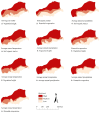Quantifying soil wind erosion attribution in Inner Mongolia's desert grassland
- PMID: 40275040
- PMCID: PMC12022335
- DOI: 10.1038/s41598-025-98339-8
Quantifying soil wind erosion attribution in Inner Mongolia's desert grassland
Abstract
Wind erosion is a major ecological challenge in the Inner Mongolia desert grassland, directly impacting regional ecological stability and sustainable development. To gain a deeper understanding of the wind erosion process and its key driving factors, this study carefully assembled 21 indicators and quantified each factor's relative contribution to wind erosion using 137Cs tracing technology and geographic detectors. Data collection methods included the acquisition of soil samples, meteorological data, and vegetation cover information through remote sensing technology, along with field measurements taken at several sampling points within the study area. Data analysis was conducted using geographic detectors, which spatially identified the key factors influencing wind erosion and quantitatively assessed their contributions. Additionally, the spatial distribution of risk zones was accurately identified, analyzing wind erosion intensity and distribution patterns across different regions. The results showed that soil organic matter (SOM), vegetation height (VH), average annual precipitation (PPT), average annual temperature (AAT), and potential evaporation (PE) were the primary contributors to wind erosion, with their explanatory powers for the wind erosion modulus being 0.60, 0.51, 0.51, 0.48, and 0.44, respectively. This study provides important theoretical support for regional wind erosion control and proposes targeted management strategies to improve management efficiency and promote ecological protection and sustainable development.
Keywords: 137Cs tracing; Geographic detectors; Impact factor; Inner Mongolia desert grassland; Quantitative attribution; Soil wind erosion.
© 2025. The Author(s).
Conflict of interest statement
Declarations. Competing interests: The authors declare no competing interests.
Figures








References
-
- Fernandez-Bernal, A. & Rosa, M. A. D. L. Arid Environments and Wind Erosion 1–13 (Nova Science Publishers, 2009).
-
- Buschiazzo, D. E. & Zobeck, T. M. Validation of WEQ, RWEQ and WEPS wind erosion for different arable land management systems in the Argentinean Pampas. Earth. Surf. Proc. Land.33 (12), 1839–1850. 10.1002/esp.1738 (2008).
-
- Borrelli, P., Ballabio, C., Panagos, P. & Montanarella, L. Wind erosion susceptibility of European soils. Geoderma232–234, 471–478. 10.1016/j.geoderma.2014.06.008 (2014).
-
- Meng, Z. et al. Interactive effects of wind speed, vegetation coverage and soil moisture in controlling wind erosion in a temperate desert steppe, inner Mongolia of China. J. Arid Land.10, 534–547. 10.1007/s40333-018-0059-1 (2018).
-
- Zhang, J. Q., Zhang, C. L., Chang, C. P. & Liu, G. Comparison of wind erosion based on measurements and SWEEP simulation: a case study in Kangbao County, Hebei Province, China. Soil Tillage. Res.165, 169–180. 10.1016/j.still.2016.08.006 (2017).
Grants and funding
LinkOut - more resources
Full Text Sources
Research Materials
Miscellaneous

